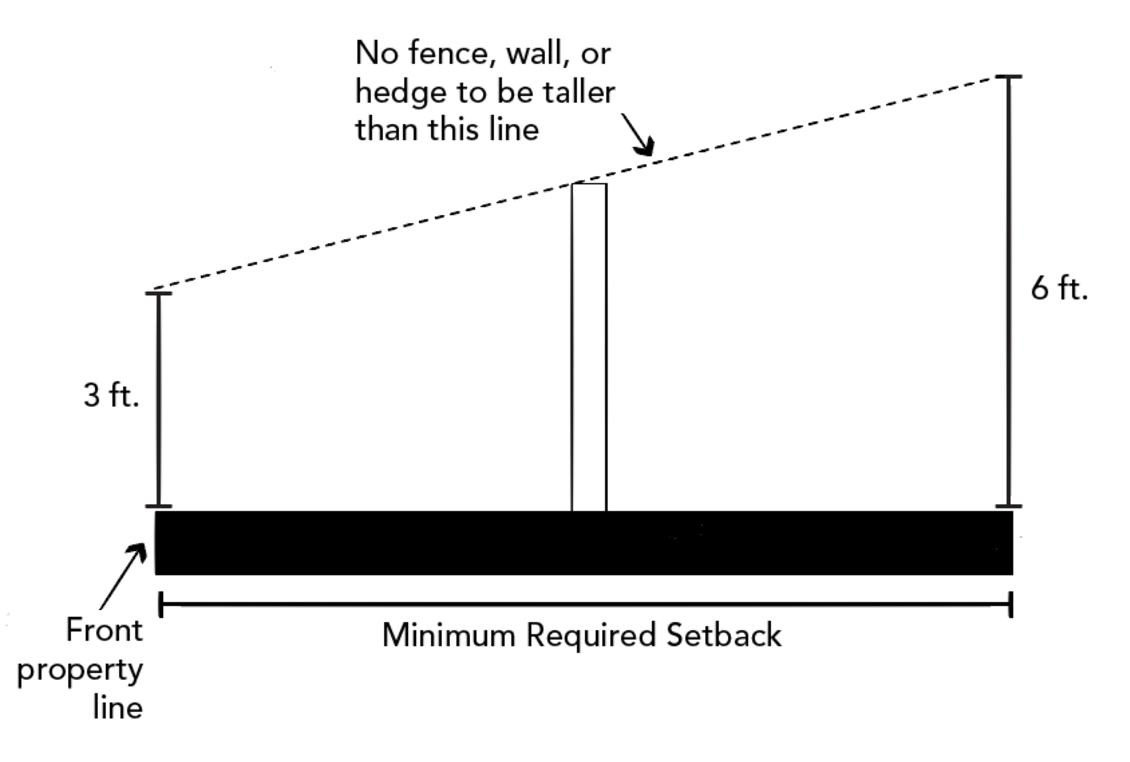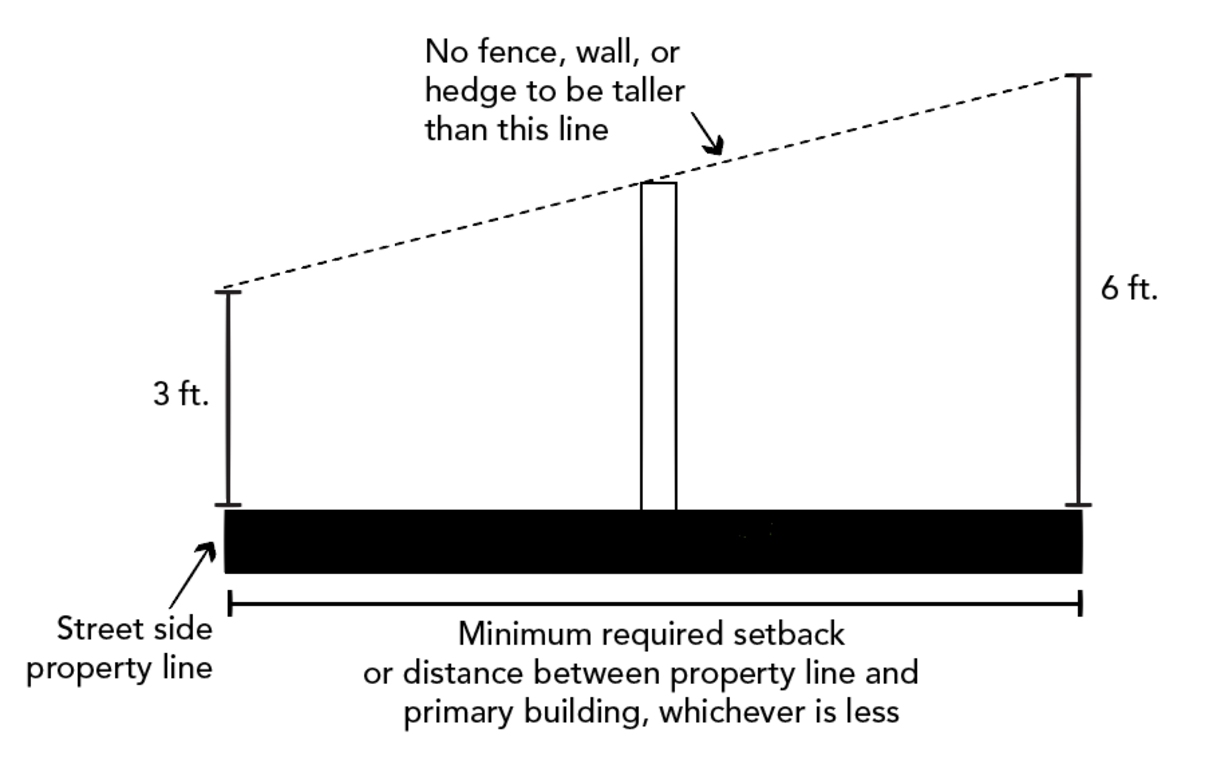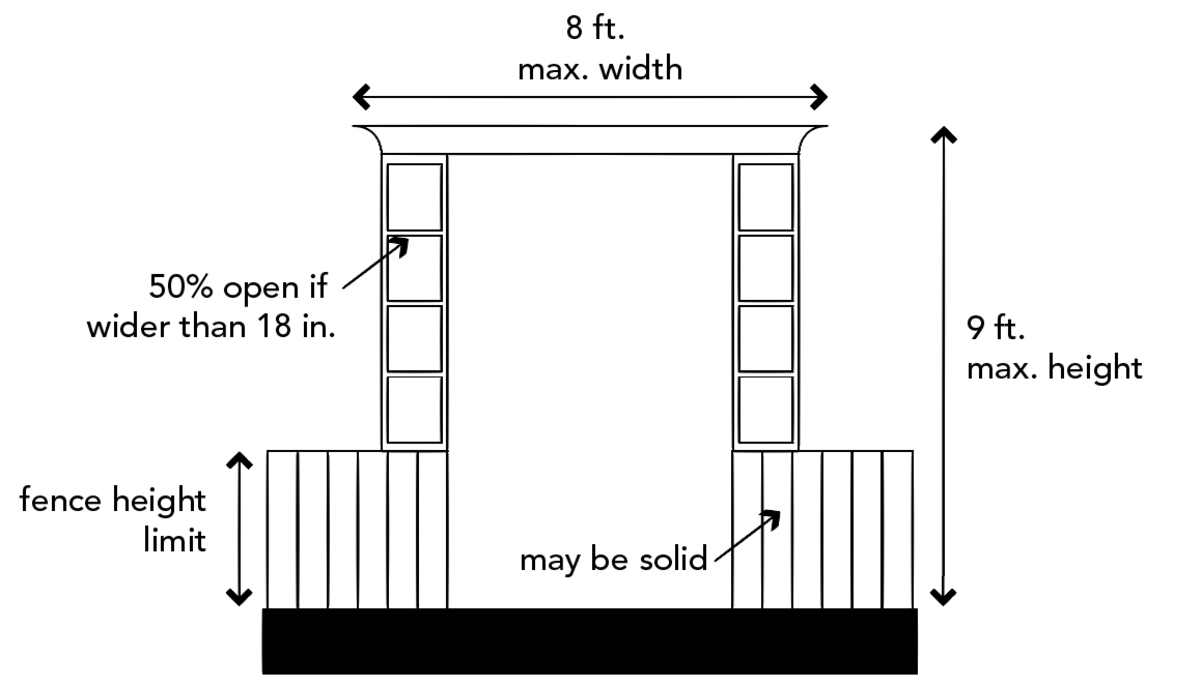17.70.070 Fences, walls, and hedges.
A. Purpose. The purpose of these regulations is to achieve a balance between concerns for privacy and public concerns for enhancement of the community appearance, visual image of the streetscape, overall character of neighborhoods, and to ensure the provision of adequate light, air, and public safety.
B. Application. These regulations apply to any type of visible or tangible obstruction that has the effect of forming a physical or visual barrier between properties or between property lines and the public right-of-way, including but not limited to: any type of artificially constructed barriers of wood, metal, or concrete posts connected by boards, rails, panels, wire or mesh, and any type of natural growth such as hedges and screen plantings.
C. Standards for Fences Located within Required Setbacks. Fences, walls or hedges may be placed within required setbacks, provided they do not exceed maximum height limitations and comply with the following standards:
1. Fence Height within Front Setback. The maximum height of a fence, wall, or hedge shall not exceed six feet; except within any front setback, the maximum fence, wall, or hedge height shall be as shown in Figure 3-4: Fence, Wall, and Hedge Height in Front Setbacks. See also Section 17.70.210 (Vision Clearance Triangle at Intersections).
Figure 3-4. Fence, Wall, and Hedge Maximum Height in Front Setbacks

2. Corner Lots Fence Height within Street Side Setbacks. On corner lots, the maximum height of a fence, wall, or hedge shall not exceed six feet; except within any street side setback, the maximum fence, wall, or hedge height shall be as shown in Figure 3-5: Fence, Wall, and Hedge Height in Street Side Setbacks (Corner Lots). See also Section 17.70.210 (Vision Clearance Triangle at Intersections).
Figure 3-5. Fence, Wall, and Hedge Maximum Height in Street Side Setbacks (Corner Lots)

3. Driveway Gates. In the R-1 zone, gates across driveways shall be set back a minimum of ten feet behind the property line. In all other zones, gates across driveways shall allow for adequate space to queue vehicles entering the property consistent with Section 12.38.040 (Parking and driveway standards).
4. Interior Side and Rear Setback Height. The maximum height of a fence, wall, or hedge in any interior side or rear setback shall be six feet.
5. Arbors, Trellises, and Ornamental Features.
a. General. Arbors, trellises, and other similar ornamental features are allowed within a required setback subject to the same height limits that apply to fences, walls, and hedges, except as provided in subsection (C)(5)(b) of this section.
b. Street Side and Front Setback. Up to one arbor, trellis, or other similar ornamental feature per street frontage is allowed with a maximum height of nine feet, and an area of not more than forty square feet as measured by the perimeter formed by the vertical projection to the ground of the outermost elements of the feature, and no horizontal dimension shall exceed eight feet in length. Any portion of such a feature wider than eighteen inches and that exceeds the usual fence height requirements of this section shall be of an open design such that a person standing on the adjacent public right-of-way can see completely through at least fifty percent of the structure to the depth of the required street yard (see Figure 3-6: Arbors in Front and Street Side Setbacks). Such features within required setbacks shall not be connected to another structure or building. For the purposes of this section, the term “connected” shall include structures that are rigidly joined by structural components. Such features within required setbacks shall not be constructed of heavy materials such as masonry or metal. Such features within required setbacks comply with Section 17.70.210 (Vision Clearance Triangle at Intersections).
Figure 3-6. Arbors in Front and Street Side Setbacks

6. Pilasters. Decorative pilasters, statuary, flower pots, and similar ornamental elements attached to or incorporated into the design of conforming fences or walls may exceed the required height limit up to 18 inches, provided that the decorative element is not wider than eighteen inches and that such elements are used to define a gateway or other entryway or are otherwise at least four feet apart.
D. Standards for Fences Located Outside of Required Setback Areas. Fences, walls, and arbors may be placed outside required setbacks, provided:
1. The maximum fence, wall, arbor or hedge height is eight feet.
2. Where the fence, wall, or arbor is connected to and a part of a building, it may be any height allowed in the underlying zone.
E. Fence Height with Difference in Grade. Fence height is measured from the adjacent grade along the lower side of the wall, fence, or hedge, directly at the base of the wall or fence.
F. Measurement of Height Where Fences or Walls Are Located on Retaining Walls.
1. Where fences or walls are located on retaining walls, the height of the retaining wall shall be considered as part of the overall height of the fence or wall. Walls or fences must have a minimum spacing of five feet between each other to be considered separate structures for purposes of measuring overall height.
2. Where fences are located on a berm or mound, the height of the fence shall include the berm or mound directly beneath the fence and above natural grade in the overall height measurement.
3. Where fences are located on retaining walls within interior side or rear setbacks, fences shall not exceed six feet as measured from the uphill side if erected or replaced on top of the retaining walls, and the combined fence and retaining wall height shall not exceed nine feet from the lower side, provided no modification of grade has occurred from the original subdivision improvements and/or design approvals. A building permit is required for the combined fence and retaining wall height that exceeds six feet. If there is evidence that a modification to the grade has occurred from the original subdivision/design approvals, the height must be authorized through a fence height exception pursuant to Chapter 17.108 (Director’s Action). For retaining walls in hillside areas, see also Section 17.70.090(C)(3) (Retaining Walls).
G. Intersection and Driveway Visibility. Notwithstanding other provisions of this section, fences, walls, and hedges shall comply with Section 17.70.210 (Vision Clearance Triangle at Intersections).
H. Director’s Action. The director, through a director’s action, may grant exceptions to standards of this section as set forth in Chapter 17.108 (Director’s Action) when there is no practical way to comply with the provisions and no other feasible alternatives will result in better implementation of other zoning regulations or general plan policies while allowing reasonable use of sites. Circumstances where a director’s action may be approved include, but are not limited to, issues related to topography and privacy. (Ord. 1705 §§ 17, 22, 2021; Ord. 1650 § 3 (Exh. B), 2018)